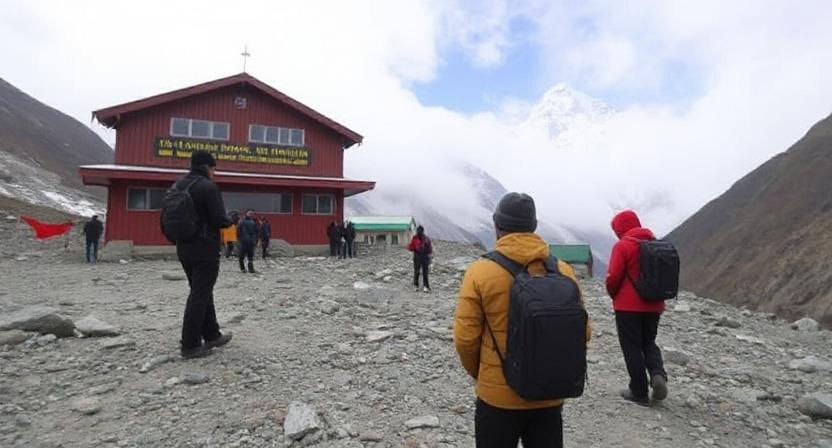Published on November 2, 2025
Flights to and from Tenzing-Hillary Airport in Lukla, the gateway to Mount Everest in Nepal, have been grounded for three days due to unfavorable weather. The region has witnessed heavy rain, an overcast sky, and fog, which has reduced visibility, grounding both aircraft and helicopter flights. According to Nawaraj Katuwal, the ATC at Lukla, flights were not possible, with the 60-odd flights that operate on a daily average in this season grounded.
It indicates the vulnerability of mountain tourism as well as the difficulties of air transport in remoter regions of Nepal. With flights grounded, tourists—many of whom had planned to return to Kathmandu after visiting the Khumbu region—are left stranded in Lukla and surrounding areas, causing severe disruptions in the tourism flow.
Advertisement
Consequences for Nepal’s Tourism Economy
Advertisement
Lukla serves as one of Nepal’s busiest tourist hubs, especially during the peak trekking season. The temporary suspension of flights has a ripple effect on tourism-related businesses in Lukla and nearby Namche Bazaar, causing economic strain for hotels, restaurants, guides, and porters who depend on the steady flow of visitors. These tourism workers and local businesses rely on constant foot traffic from trekkers and mountain expeditions, which provides vital income throughout the year. When travel disruptions occur, many local operators face cancellations, and overbooked hotels are left to accommodate tourists longer than expected.
In addition to local accommodations, transportation services that are dependent on airline operations in Lukla also face financial consequences. Without flights, tourists attempting to reach Kathmandu or other destinations must rely on land-based travel, which can be time-consuming, unsafe, and inaccessible due to landslides and road conditions. This further adds to the burden on tourist infrastructure in the region.
The Need for Resilient Tourism Infrastructure in the Himalayas
The Lukla flight suspension reveals how Nepal’s mountain tourism sector remains vulnerable to weather disruptions that impact key tourist destinations in the Himalayas. For Nepal, where mountain tourism accounts for a substantial portion of the national economy, ensuring resilient tourism infrastructure is essential. As mountain tourism grows, it is critical to invest in alternative transportation routes—such as improving road access or **developing helicopter services—to ensure that tourists can safely travel in the event of flight cancellations.
In addition, enhancing mountain rescue capabilities and improving communication systems in remote trekking areas will help Nepal’s tourism sector remain resilient. Such investments will also ensure that the safety of tourists is prioritized during emergency situations, allowing Nepal to maintain its reputation as a safe and reliable destination for adventure tourism.
Advertisement
Growing Demand for Sustainable and Responsible Tourism in Nepal
Advertisement
As Nepal’s tourism industry recovers from the pandemic and prepares for future growth, the demand for sustainable and responsible tourism continues to rise. The recent Lukla flight disruptions serve as a reminder of the growing importance of sustainable travel in the country. More tourists are seeking eco-friendly and low-impact travel experiences, especially in remote regions like the Everest region, which is known for its fragile ecosystems and unique wildlife.
Nepal’s government and tourism stakeholders are increasingly focused on ensuring that tourism growth does not come at the expense of the country’s environmental health. There is a growing push to integrate eco-tourism practices into the country’s mountain tourism policies, ensuring that mountain trekkers and tourists are aware of their environmental responsibilities. This includes promoting sustainable travel options such as low-carbon transportation, waste management practices, and local community engagement in the tourism process.
Potential Solutions: Diversified Travel and Improved Tourist Experience
The challenges faced by tourists stranded in Lukla also highlight the need for diversified travel options and improved visitor experiences in Nepal. By creating more diverse tourism routes and transportation infrastructure, Nepal’s tourism sector can ensure that tourists are not left stranded when weather disruptions occur. This could include land-based alternatives, such as off-road transport options, or more extensive helicopter services in areas where airports are inaccessible due to weather conditions.
Additionally, tourism operators in Nepal should continue to enhance their services by providing flexible itineraries, advance travel options, and communication systems that allow tourists to quickly adapt to unforeseen changes in their travel plans. This focus on visitor satisfaction will help mitigate the impact of unexpected disruptions and foster tourism loyalty among travelers who have positive experiences during their mountain adventures.
Strengthening Nepal’s Position as a Leading Adventure Tourism Hub
Despite the challenges posed by weather disruptions like the Lukla flight suspension, Nepal’s tourism sector continues to recover and grow. The country remains one of the world’s top destinations for adventure tourism, especially trekking, mountaineering, and eco-tourism. The recent success of the FIBA Men’s Basketball World Championship and the FIVB Women’s World Volleyball Championship demonstrates Nepal’s ability to host large-scale events while highlighting its mountain tourism offerings.
To maintain and strengthen its global position as an adventure tourism leader, Nepal will need to continue investing in high-altitude infrastructure, safe tourism practices, and eco-friendly tourism strategies. By focusing on safety, sustainability, and quality experiences, Nepal can ensure the long-term success and sustainability of its mountain tourism industry.
A Call for Resilient Tourism Infrastructure in Nepal
The recent stranding of tourists in Tilicho Base Camp and Lukla reminds one of the challenges inherent in Nepal’s mountainous tourism sector. The increasing appeal of the country as a tourist destination calls for corresponding investment in reliable transportation infrastructure, besides high-altitude rescue capabilities. Thus, making access easier and ensuring improved mobility of tourists, Nepal should be able to continue to remain at the apex in adventure tourism while providing safety and sustainability for tourists on its trekking expeditions.
Provided the sector continues to adapt to climate challenges and the growing demands of responsible tourism, Nepal’s tourism could continue to be one of its most lucrative industries. If relevant investments and policies are directed properly, Nepal’s mountain tourism will keep receiving international visitors and will help promote economic growth with sustainable development in Nepal’s remote mountainous regions.
Advertisement
Tags: challenges of mountain tourism Nepal, Lukla flights suspended weather Nepal tourism, Nepal mountain tourism transportation issues, Tenzing-Hillary Airport flight disruptions, tourists stranded Lukla weather delay
Advertisement
Tags: challenges of mountain tourism Nepal, Lukla flights suspended weather Nepal tourism, Nepal mountain tourism transportation issues, Tenzing-Hillary Airport flight disruptions, tourists stranded Lukla weather delay
Subscribe to our Newsletters
I want to receive travel news and trade event updates from Travel And Tour World. I have read Travel And Tour World's Privacy Notice .
Sunday, November 2, 2025
Sunday, November 2, 2025
Sunday, November 2, 2025
Sunday, November 2, 2025
Sunday, November 2, 2025
Sunday, November 2, 2025
Sunday, November 2, 2025
Sunday, November 2, 2025




